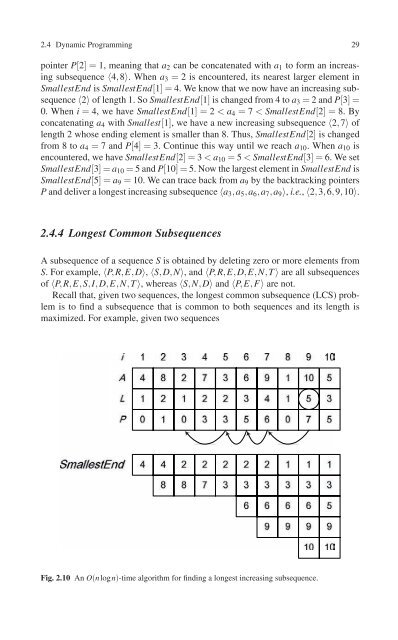You also want an ePaper? Increase the reach of your titles
YUMPU automatically turns print PDFs into web optimized ePapers that Google loves.
2.4 Dynamic Programming 29<br />
pointer P[2]=1, meaning that a 2 can be concatenated with a 1 to form an increasing<br />
subsequence 〈4,8〉. When a 3 = 2 is encountered, its nearest larger element in<br />
SmallestEnd is SmallestEnd[1]=4. We know that we now have an increasing subsequence<br />
〈2〉 of length 1. So SmallestEnd[1] is changed from 4 to a 3 = 2 and P[3]=<br />
0. When i = 4, we have SmallestEnd[1] =2 < a 4 = 7 < SmallestEnd[2] =8. By<br />
concatenating a 4 with Smallest[1], we have a new increasing subsequence 〈2,7〉 of<br />
length 2 whose ending element is smaller than 8. Thus, SmallestEnd[2] is changed<br />
from 8 to a 4 = 7 and P[4]=3. Continue this way until we reach a 10 . When a 10 is<br />
encountered, we have SmallestEnd[2]=3 < a 10 = 5 < SmallestEnd[3]=6. We set<br />
SmallestEnd[3]=a 10 = 5 and P[10]=5. Now the largest element in SmallestEnd is<br />
SmallestEnd[5]=a 9 = 10. We can trace back from a 9 by the backtracking pointers<br />
P and deliver a longest increasing subsequence 〈a 3 ,a 5 ,a 6 ,a 7 ,a 9 〉, i.e., 〈2,3,6,9,10〉.<br />
2.4.4 Longest Common Subsequences<br />
A subsequence of a sequence S is obtained by deleting zero or more elements from<br />
S. For example, 〈P,R,E,D〉, 〈S,D,N〉, and 〈P,R,E,D,E,N,T〉 are all subsequences<br />
of 〈P,R,E,S,I,D,E,N,T 〉, whereas 〈S,N,D〉 and 〈P,E,F〉 are not.<br />
Recall that, given two sequences, the longest common subsequence (LCS) problem<br />
is to find a subsequence that is common to both sequences and its length is<br />
maximized. For example, given two sequences<br />
Fig. 2.10 An O(nlogn)-time algorithm for finding a longest increasing subsequence.

















